| Home |
Videos |
Slides |
Assignments & Resources | Tests |
Exams |
YODA Topics |
Hall of Fame |

Lecture Slides!
2014 Slides:
| # |
Link to slides |
Description (and link to video
where available) |
Resources |
| 00 | 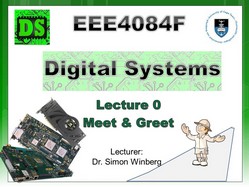 |
Lecture
00: Meet & Greet (optional)
This is a pre start of lectures, intended to be provided in
the form of a video. |
Quiz0 |
| 01 | 
|
Lecture 01: IntroductionTeaching staff & practical times. Relevance to you. Quiz 0. Course objectives. Syllabus in brief & the textbook. Your and my Initial impressions. Reading task & Homework #1. Lecture 01 condensed video Lecture 01 condensed video |
|
| 02 |
 |
Lecture 02: Parallel Computing FundamentalsReview of Quiz 0. UML recap in 5 minutes. Parallel computing fundamentals. Automatic parallelism. Performance benchmarking. Trends. Lecture
02 condensed video Lecture
02 condensed video |
|
| 03 |
 |
Lecture 03: Temporal and Spatial ComputingPrac Issues, Seminar planning, Temporal & spatial computing, Benchmarking, Power Lecture 03
condensed video Lecture 03
condensed video |
Take-Home Assignment Readings: 1. Intel Processor History. |
| 04 |  |
Lecture 04: Timing & Programming ModelsTiming in C, Review of homework (scalar product), Important terms, Data parallel model, Message passing model, Shared memory model, Hybrid model. Lecture 04
condensed video Lecture 04
condensed video |
Code Examples: 1. Parallel Programming 2. Timing |
| 05 | 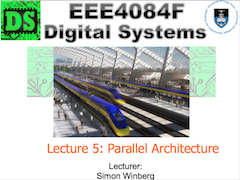 |
Lecture 05: Parallel ArchitecturesPrac2 discussion, Processor Architecture types, Von Neumann; Flynn's taxonomy, Class activity, Memory access architectures. Lecture 05
condensed video Lecture 05
condensed video |
Class Activity  |
| 06 |
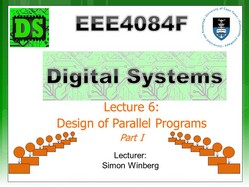 |
Lecture 06: Design of Parallel Programs (Part 1)Seminar this afternoon, About Homework 2, Recap of memory architectures, Steps in designing parallel programs, Step 1: understanding the problem, Step 2: partitioning, Step 3: decomposition & granuality. Lecture 06
condensed video Lecture 06
condensed video |
|
| 07 |
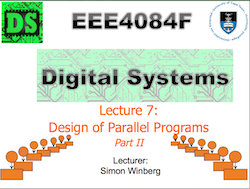 |
Lecture 07: Design of Parallel Programs (Part 2)Covers from Step 3: decomposition and granularity, Class activity, Step 4: communications Design of Parallel Programs (Part 2).Aside: IBM Watson (a mega 'game console' case study).  Lecture 07
condensed video Lecture 07
condensed video |
|
| 08 | 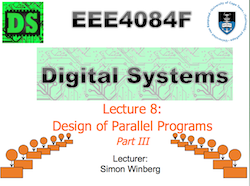 |
Lecture 08: Design of Parallel Programs (Part 3)Step 4: communications (cont), Cloud computing, Step 5: Identify data dependencies. Lecture 08
condensed video Lecture 08
condensed video |
|
| 09 | 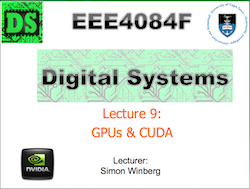 |
Lecture 09: GPUs and CUDASeminar reminder, CUDA & Prac2, Parallel Programming cont., Identifying Data Dependencies, Synchronization. Lecture 09
condensed video Lecture 09
condensed video |
 |
| 10 | 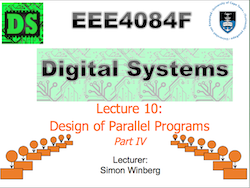 |
Lecture 10: Design of Parallel Programs (Part 4)Planning Step 7: Load balancing, Step 8: Performance analysis and tuning. Lecture 10
condensed video Lecture 10
condensed video |
Code Examples: 1. get time of day timing 2. Timing |
| 11 |  |
Lecture 11: Parallel Design PatternsParallel design patterns, Terms, Where to in Term 2. Lecture 11
condensed video Lecture 11
condensed video |
Class Activity Readings: 1. Kim 2004-Parrallel Programming Patterns. 2. Siu Design Patterns for Parallel Programming |
| 12 | 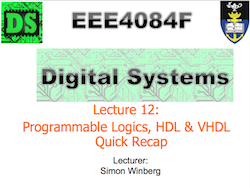 |
Lecture 12: Programmable LogicReview of short exercise re digital accelerator, VHDL recap Lecture 12
condensed video Lecture 12
condensed video |
|
| 13 | 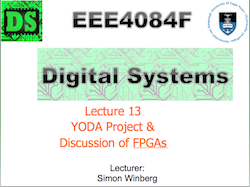 |
Lecture 13: YODA Project and FPGAsYODA Project, FPGA Families Lecture 13
condensed video Lecture 13
condensed video |
|
| 14 | 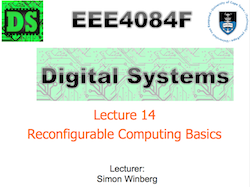 |
Lecture 14: Reconfigurable Computing BasicsReconfigurable Computing Basics, Brainstorming exercise, Introduction to Verilog. Lecture 14
condensed video. Lecture 14
condensed video. |
|
| 15 | 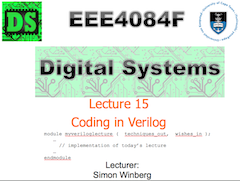 |
Lecture 15: Coding in VerilogBasics of Verilog, Coding Exercise, Verilog simulators. Lecture 15
condensed video Lecture 15
condensed video |
References: 1. Verilog 2. Verilog tutorial 3. Verilog cheat-sheet 4. Verilog quick reference 5. Introduction to Verilog 6. Verilog-A:An Introduction for Compact Modelers 7. Timing tool application Manual Code Examples: 1. Verilog |
| 16 | 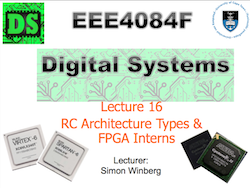 |
Lecture 16: RC Architecture Types & FPGA InternsReminders, RC Architecture overview & main types, Recap of FPGAs. Lecture 16
condensed video Lecture 16
condensed video |
|
| 17 | 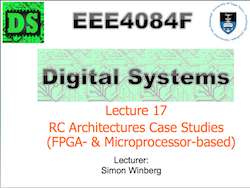 |
Lecture 17: RC Architectures Case StudiesCase study of RC computers. Lecture 17
condensed video Lecture 17
condensed video |
Readings: 1. Reconfigurable Computing A Survey of Systems and Software. 2. The cell architecture |
| 18 | 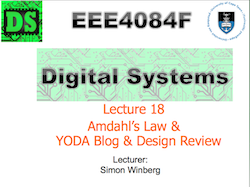 |
Lecture 18:Amdahl's LawYoda phase 1 & 2, Amdahl's Law. Lecture
18 condensed video Lecture
18 condensed video |
Readings: 1. Amdahl’s Law in the Multicore Era References: 1. Amdahl's Law. 2. Amdahl's Law |
| 19 | 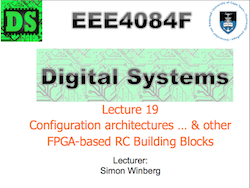 |
Lecture 19: Configuration ArchitecturesConfiguration architectures, Short video on NIOS II RC Building blocks, Memories, DMA, Digital Signals, Signal Latching. Lecture 19
condensed video Lecture 19
condensed video |
Readings: 1. Hauck 1998: FPGAs in Reprogrammable Systems |
| 20 | 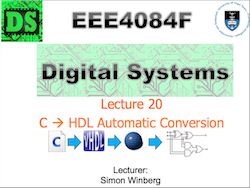 |
Lecture 20: C to HDL Automatic ConversionReminders, C HDL automatic conversion, Overview of conversion process, Limitations, Scenario Mapping C to VHDL behavioural, Some tools. Lecture 20
condensed video Lecture 20
condensed video |
Class Activity Readings: 1. C to VHDL translation tool language specification Code Examples: 1. Handle C example |
| 21 | 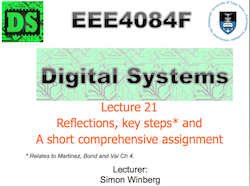 |
Lecture 21: ReflectionsKey steps to consider Class activity: A comprehensive short assignment to discuss in groups. Lecture 21
condensed video Lecture 21
condensed video |
Class Activity Readings: 1. Dorsey Top10 Reasons Systems Projects Fail References: 1. (Re)configurable Computing Case Studies 2. Contrasting Processors:Fixed and Configurable 3. System Development |
| 22 | 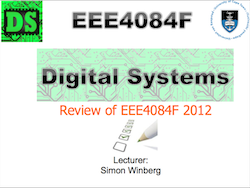 |
Lecture 22: Review of the CourseLecture content, covered Readings, seminars, chapters. Lecture 22
condensed video Lecture 22
condensed video |
Course Evaluation Examination Syllabus |
Related WebsitesDepartment of Electrical Engineering
Maintained by Simon Winberg @2014 Updated by Tumisang Leqele |
This site uses the Creative Common License: Attribution 3.0 Unported
